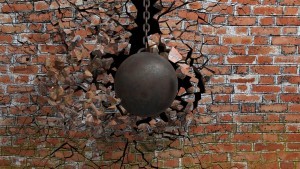Are you aware of the regulations that govern demolition of buildings, bridges, and other structures? Did you know that regardless of the type of structure being demolished, the same set of OSHA standards apply?
Before you start tearing down that next structure, it's important to have your safety protocol in place. You'll want to be sure you comply with the appropriate OSHA standards, and that you're taking the right steps to keep everyone in the area safe.
These four important measures will help get you on the right path to safe demolition. Read on to find out more.
The Basics of Demolition
1. Training Your Employees – Who is Responsible?
When it comes to demolition, it's important to make sure that only experienced and properly trained employees perform this type of work. Contrary to industry belief, demolition is far from an unskilled task. Removing any structural member can destabilize the entire structure, and increase the chance of unplanned collapse. Only employees who have been trained thoroughly under the supervision of a competent person should ever be allowed to perform this type of work.
It is the employer’s responsibility to provide training for the specific work environments that will be encountered during the demolition process. OSHA clearly defines this duty in 1926.21(b)(2).
2. Provide Proper PPE – More Than the Simple Stuff
One would hope this would be obvious, but based on our anecdotal observations, one would be wrong! It is critical that all personnel not only have the correct equipment on hand, but they must be using it properly. This includes the basics - hardhats, safety vests, proper eyewear, hearing protection, gloves, steel-toed boots, etc.
Depending on the type of demolition, specialty project specific equipment may also be required. This could include fall protection, respirators, hazmat suits, and other items.
The Competent Person is responsible for making an assessment of the job site to determine what specific hazards may be encountered, and what equipment will be necessary.
3. Brace! Stabilize! Brace! Stabilize!
Question – would you remove the legs from a table while eating dinner from it, expecting it not to fall over (this is not a trick question)? Of course not! Similarly, would you think it is ok to remove structural supports from a bridge or building without first figuring out how to stabilize it? Let’s all pray the answer to that is “no” as well!
OSHA 1926.850(a) requires that prior to demolishing any structure, an engineering survey by a Competent Person must be performed. If the structure is complex, a Qualified Person (i.e. professional engineer) may be required to provide a sequenced demolition plan with engineered bracing and shoring layouts.
Demolition of large structures is tricky business. When in doubt, get an engineer involved.
4. Clean Up Properly
After demolition is complete, your work isn't over. It's also important to make sure the cleanup process is done safely.
Jagged concrete and exposed rebar are just two of many hazards encountered after the jackhammering has stopped. When possible, it is always recommended to utilize loaders and skid steers for debris removal. If hand removal is required, the competent person needs to be extremely vigilant to ensure employees handle the debris piles safely.
Final Thoughts
Thousands of demolition projects are completed safely every year. Following these tips (which are by no means exhaustive) along with the guidance provided in OSHA Subpart T will help ensure your next demolition project is done safely as well.
Need help with an upcoming demolition project?
Get in touch with our demolition engineers today and learn how we can help.









